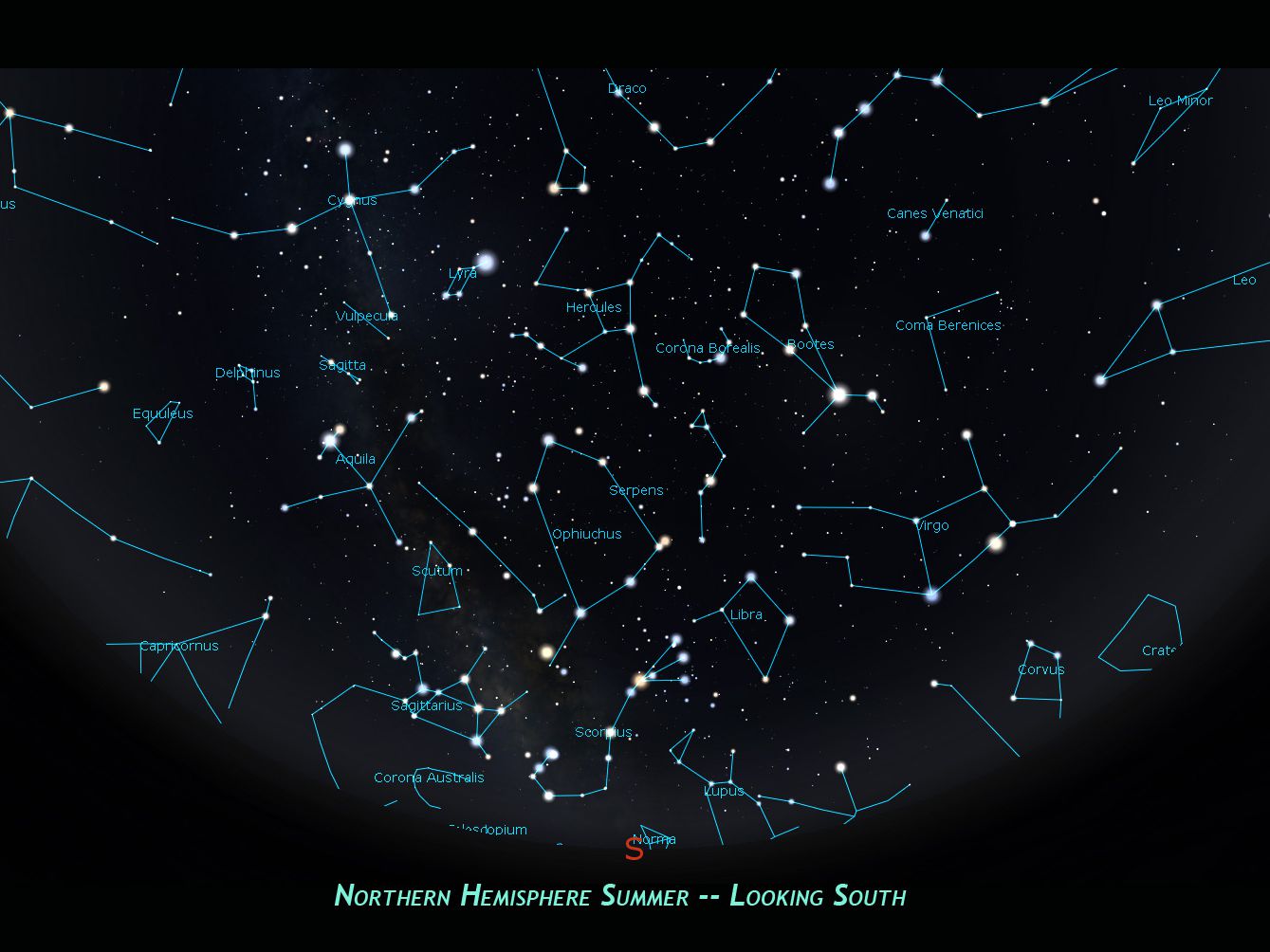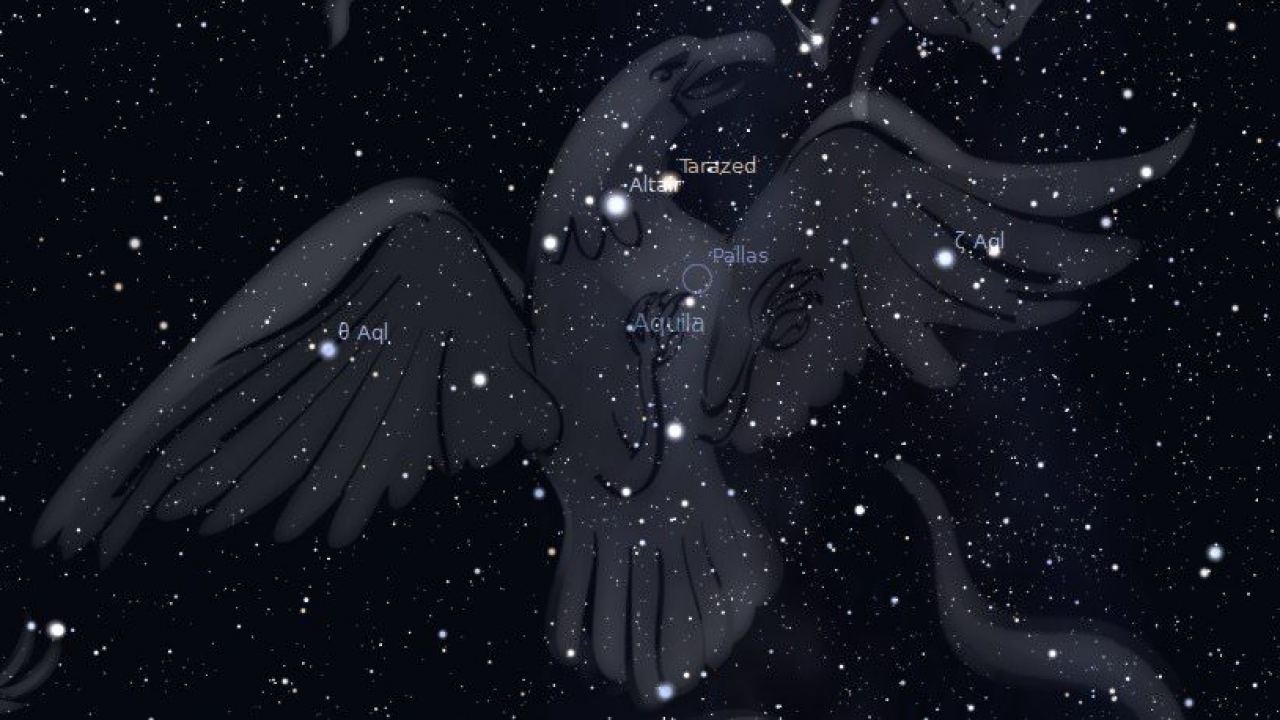Aquila Constellation the Eagle; Facts, Stars, Location, Deep, Myth
- Home
- chevron_right
- Astronomy
- chevron_right
- Aquila Constellation the Eagle; Facts, Stars, Location, Deep, Myth
Aquila ranked as the 22nd largest constellation, is easily recognizable in the night sky, making it hard to miss. It is positioned among the largest constellations and is located approximately 32.6 light-years away from Earth. The credit for the discovery of Aquila goes to Ptolemy, a Greek scientist, and astronomer who cataloged a total of 48 constellations, including Aquila. The name “Aquila” is derived from the ancient Romance language and translates to “Eagle.” This naming convention follows the tradition of many constellations being named after figures from Roman mythology, which includes legendary heroes such as Hercules, Marcus, Aeneas, and Evander of Pallene.
In reality, the constellation Aquila does resemble a bird in the sky. In Roman mythology, it is associated with an eagle carrying the thunderbolt of Jupiter, the King of the Gods. It is intriguing to note the similarities between the Aquila constellation in Greek and Roman mythology, as in Greek mythology, it is believed that the eagle carries the thunderbolt of Zeus. Another story from Greek mythology involves the eagle serving as the guardian of the love arrow belonging to Eros, the god of love. Zeus was struck by the love arrow and subsequently fell in love with Nemesis, the goddess of retribution.
Aquila holds significance as one of the most prominent constellations, resembling a bird with expansive wings and a short neck. It has been recognized in the Western world since 1200 BC as a bird situated along the Milky Way during the summer months. Located in the northern sky on the celestial equator, Aquila consists of ten relatively faint stars arranged in the shape of a rhombus. It is visible at latitudes ranging from +90 to -75 degrees. The Latin name for this constellation is “Eagle.” Aquila spans both hemispheres and can be observed during the summer and autumn seasons. It is in proximity to constellations such as Scutum, Serpens Cauda, Aquarius, Capricornus, Delphinus, Hercules, Sagitta, Sagittarius, and Ophiuchus.
How to find the Aquila constellation in the night sky?
If you’re eager to locate the Aquila constellation in the night sky, the best time to do so is during the northern summer, which spans from June 1 to August 31. This period offers optimal conditions for observing the constellation. Additionally, the Aquila constellation is situated along the Milky Way, making it easier to find by navigating in the opposite direction of the celestial Swan.
Having knowledge of constellations can greatly aid in identifying celestial objects and studying their movements within the solar system relative to the stars. Discovering and familiarizing oneself with constellations is an exciting pursuit for astronomers and stargazers alike. Amateurs who possess skills in recognizing constellations have a valuable asset. However, finding constellations requires understanding their principles, utilizing tips, and employing appropriate tools.
Locating the Aquila constellation, characterized by a diamond-like shape, is relatively straightforward. Simply direct your gaze towards the southern and eastern regions of the sky along the path of the Milky Way, following the constellation Cygnus. The brightest star within the Aquila constellation will guide you to your destination.

Some facts about the Aquila constellation
The Aquila constellation is surrounded by several other constellations, including:
- Capricornus: Positioned near Aquila, this constellation represents the mythical sea goat.
- Serpens Cauda: Located close to Aquila, this constellation forms the tail of the celestial serpent.
- Sagittarius: Adjacent to Aquila, Sagittarius is known as the archer constellation.
- Hercules: Positioned near Aquila, Hercules is a constellation representing the legendary hero.
- Ophiuchus: Situated near Aquila, Ophiuchus is often referred to as the serpent-bearer constellation.
Important Deep Space Objects in the Aquila Constellation:
- The Phantom Streak Nebula: Located approximately 7,000 light-years away, this planetary nebula formed from the ejected gas of a dying star over thousands of years.
- Glowing Eye Nebula: Situated roughly 6,500 light-years away, this nebula captivates with its luminous appearance.
- Open clusters like NGC 6709 and NGC 6755 are found in the Aquila constellation.
- The Hercules-Corona Borealis Great Wall: Noteworthy for its massive size, this single mass concentration is considered the largest in the Milky Way.
Extraordinary Events in the History of Aquila:
Two significant novae have been recorded in the history of the Aquila constellation:
- The first novae occurred in 389 BC.
- The second novae took place in 1918, surpassing the brightness of the Altair Star and leaving a remarkable astronomical event in its wake.

Discovered Stars in the Aquila constellation
Right now, there are 10 stars discovered, all of which have planets floating around. The names of some of these stars are given next:
- Altair α Aquilae (Alpha Aquilae): This star is known to be the brightest one within this constellation. In terms of brightness, this star is ranked 12th in the constellation of Aquila. Altair, which is an Arabic word meaning “Bird”, is a dwarf star that is rotating at a very high speed. Scientists have estimated this speed to be 178 mil/sec. It is interesting to note that this is one of the closest stars to our planet (apparent magnitude: 0.76) and, as mentioned, it is the 12th brightest star. Hence, you can easily see this dwarf start without using any type of equipment. The characteristics of Altair are as follows:
-
- Altair is bigger than our sun by about 1.63 times
- It is an interstellar cloud of gas
- The brightness of Altair is also 10.6 times more than the sun.
- Alshain β Aquilae (Beta Aquilae): A class G subgiant that is located about 44.7 light-years away from Aquila. This star was first observed by German uranography, Johann Bayer. The characteristics of Alshain are as follows:
- This is a class G subgiant and is located to be 44.7 light-years away from Earth.
- In terms of visual companion, this star is ranked 12th. After this star, numerous other stars are placed on this list, some of which are given as follows:
-
-
- Beta Aquilae B
- Red dwarf
-
-
- In terms of brightness, Alshain’s brightness is higher than the sun’s.
- The apparent magnitude of the Alshahin star is approximately 3.71.
- Tarazed γ Aquilae (Gamma Aquilae): A class K giant. It is interesting to note that this star shines 2960 times more than our sun and it is a significant source of X-rays. Among the stars around the Aquila constellation, Tarazed is the youngest one, the creation of which goes back to 100 million years ago. The characteristics of Tarazed are as follows:
- In comparison to our sun, this orange-hued star is brighter by approximately 2,538 times.
- It is interesting to note that the size of this star is also much bigger than our son’s or to be exact 9500%.
- The apparent magnitude of 2.712
- Deneb el Okab ζ Aquilae (Zeta Aquilae): This triple star system is positioned approximately 154 light-years away from our planet, earth. Deneb el Okab, which is also called Zeta Aquilae, is a main-sequence star and its color varies between blue and white. The name of this star originated from an Arabic phrase that translates to “Tail of the Eagle”. The characteristics of Deneb el Okab are as follows:
- Deneb el Okab is located 83 light-years from the Earth.
- Just like its counterpart, Altair Star, Deneb el Okab is also considered a fast-spinning star. Based on the calculations, its rotation speed can be 196.9 miles/sec.
- An equatorial radius is more than the polar radius, calculated to be approximately 30.7%.
- In terms of brightness, Deneb el Okab is ranked as the 3rd brightest start.
- Eta Aquilae Bezek (η Aquilae): This star is a supergiant, a mix of yellow and white colors, that is located about 1,383 light-years from Earth. The fifth brightest star (apparent magnitude: 3.87) in the Aquila constellation is associated with Eta Aquilae which is a system consisting of several stars. Before becoming part of this constellation, Eta Aquilae was a member of the Antinous constellation. The characteristics of Eta Aquilae are as follows:
- The distance between Eta Aquilae and our earth is more than 1,380 light-years.
- As a Cepheid variable star, the magnitude of the star can vary between 3.4 and 4.3. This will happen for 7.16 days.
- It should be also mentioned that this star is brighter than our sun, almost 2,630 times.
- 15 Aquilae: A giant star that is floating around 289 light-years away from our planet and has an apparent magnitude of 5.41. Although this bright giant star is firing up at a temperature of 4,560 K, its surface is much cooler than other stars in the Aquila constellation. We have not obtained information regarding the mass of 15 Aquilae, however, it is 1,400% bigger than our sun.
- FF Aquilae: A supergiant whose color is something between yellow and white. This supergiant is burning hotter than our sun, with its surface temperature reaching about 6195 K. Some of the characteristics of this star are given as follows:
- As a Cepheid variable star, the magnitude of the star can vary between 5.18 and 5.51 and will happen for 4.47 days.
- Earth is located about 350 light-years away from FF Aquilae.
- In addition to a higher temperature, FF Aquilae is even larger than the sun, which is around 3,900% of the sun’s radius.
- Theta Aquilae Tseen Foo (θ Aquilae): It is a binary star about 287 light-years away. The name Tsin Fu is derived from the Mandarin word Tianfu, which means “heavenly knife” as well as “drum stick.” Tseen Foo is a type B white clue giant with an apparent magnitude of 3.24.
- Lambda Aquilae Al Thalimain ( λ Aquilae): The Lambda Aquilae, a blue, white, B-type main sequence dwarf, is sometimes called the Al Thalimain before distinguishing it from the Iota Aquilae. Lambda Aquilae has an apparent magnitude of 3.43 and is 125 light-years away.
- Rho Aquilae
- Al Thalimain – ι Aquilae (Iota Aquilae): Iota Aquilae is a blue-white B-type star about 307 light-years away. Al Thalimain, which the star associates with Lambda Aquilae, means “two ostriches” in Arabic. Its apparent magnitude is 4.36.
References:
Recent Posts
- What is Gravity?
- whirlpool galaxy (Messier 51); Facts, Location, Type
- Astronomy; Definition, Types, History and Facts
- Draco Constellation; Facts, Myth, Location, Stars
- Cassiopeia Constellation: Facts, Myth, Location, Stars
- Zodiac Constellations; Facts, Stars, Symbols, Dates, Signs
- Atik Star Omicron Persei; +10 Facts, Myth, Features
- Algol Star β Persei; +10 Facts, Myth, Features
Suggest Posts
- What is Gravity?
- whirlpool galaxy (Messier 51); Facts, Location, Type
- Astronomy; Definition, Types, History and Facts
- Draco Constellation; Facts, Myth, Location, Stars
- Cassiopeia Constellation: Facts, Myth, Location, Stars
- Zodiac Constellations; Facts, Stars, Symbols, Dates, Signs
- Atik Star Omicron Persei; +10 Facts, Myth, Features
- Algol Star β Persei; +10 Facts, Myth, Features
Categories

Nazanin Teymoori
Hi there, I am Nazanin, a member of the Aquilae Constellation team. And also the author of all the texts of this blog.
I am delighted that after many years of great interest in astronomy, I launched this website with the help of our professional team. We have many challenges ahead of us, but we promise ourselves that we will overcome everything.
I love astronomy So Let's go




